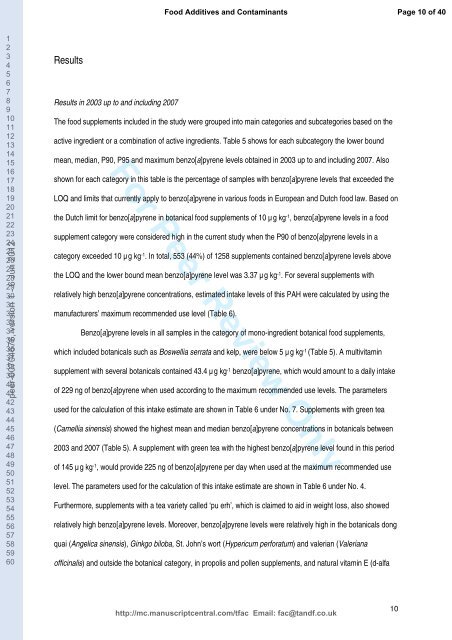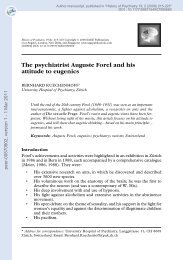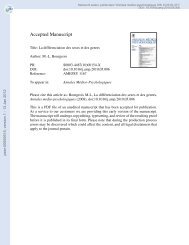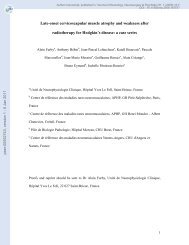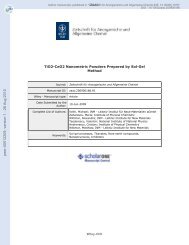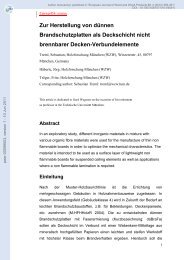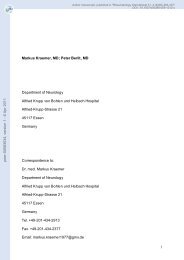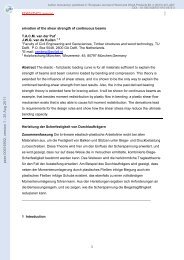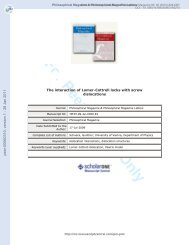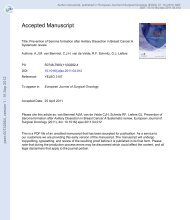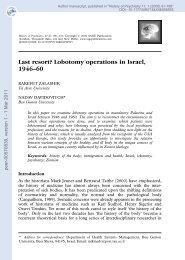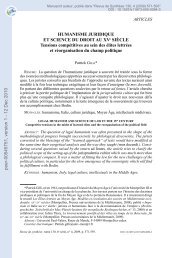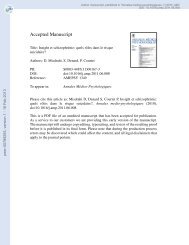Monitoring of Polycyclic Aromatic Hydrocarbons (PAH) in food ...
Monitoring of Polycyclic Aromatic Hydrocarbons (PAH) in food ...
Monitoring of Polycyclic Aromatic Hydrocarbons (PAH) in food ...
Create successful ePaper yourself
Turn your PDF publications into a flip-book with our unique Google optimized e-Paper software.
1<br />
2<br />
3<br />
4<br />
5<br />
6<br />
7<br />
8<br />
9<br />
10<br />
11<br />
12<br />
13<br />
14<br />
15<br />
16<br />
17<br />
18<br />
19<br />
20<br />
21<br />
22<br />
23<br />
24<br />
25<br />
26<br />
27<br />
28<br />
29<br />
30<br />
31<br />
32<br />
33<br />
34<br />
35<br />
36<br />
37<br />
38<br />
39<br />
40<br />
peer-00704676, version 1 - 6 Jun 2012<br />
41<br />
42<br />
43<br />
44<br />
45<br />
46<br />
47<br />
48<br />
49<br />
50<br />
51<br />
52<br />
53<br />
54<br />
55<br />
56<br />
57<br />
58<br />
59<br />
60<br />
Results<br />
Results <strong>in</strong> 2003 up to and <strong>in</strong>clud<strong>in</strong>g 2007<br />
Food Additives and Contam<strong>in</strong>ants<br />
The <strong>food</strong> supplements <strong>in</strong>cluded <strong>in</strong> the study were grouped <strong>in</strong>to ma<strong>in</strong> categories and subcategories based on the<br />
active <strong>in</strong>gredient or a comb<strong>in</strong>ation <strong>of</strong> active <strong>in</strong>gredients. Table 5 shows for each subcategory the lower bound<br />
For Peer Review Only<br />
mean, median, P90, P95 and maximum benzo[a]pyrene levels obta<strong>in</strong>ed <strong>in</strong> 2003 up to and <strong>in</strong>clud<strong>in</strong>g 2007. Also<br />
shown for each category <strong>in</strong> this table is the percentage <strong>of</strong> samples with benzo[a]pyrene levels that exceeded the<br />
LOQ and limits that currently apply to benzo[a]pyrene <strong>in</strong> various <strong>food</strong>s <strong>in</strong> European and Dutch <strong>food</strong> law. Based on<br />
the Dutch limit for benzo[a]pyrene <strong>in</strong> botanical <strong>food</strong> supplements <strong>of</strong> 10 µ g kg -1 , benzo[a]pyrene levels <strong>in</strong> a <strong>food</strong><br />
supplement category were considered high <strong>in</strong> the current study when the P90 <strong>of</strong> benzo[a]pyrene levels <strong>in</strong> a<br />
category exceeded 10 µg kg -1 . In total, 553 (44%) <strong>of</strong> 1258 supplements conta<strong>in</strong>ed benzo[a]pyrene levels above<br />
the LOQ and the lower bound mean benzo[a]pyrene level was 3.37 µg kg -1 . For several supplements with<br />
relatively high benzo[a]pyrene concentrations, estimated <strong>in</strong>take levels <strong>of</strong> this <strong>PAH</strong> were calculated by us<strong>in</strong>g the<br />
manufacturers’ maximum recommended use level (Table 6).<br />
Benzo[a]pyrene levels <strong>in</strong> all samples <strong>in</strong> the category <strong>of</strong> mono-<strong>in</strong>gredient botanical <strong>food</strong> supplements,<br />
which <strong>in</strong>cluded botanicals such as Boswellia serrata and kelp, were below 5 µ g kg -1 (Table 5). A multivitam<strong>in</strong><br />
supplement with several botanicals conta<strong>in</strong>ed 43.4 µ g kg -1 benzo[a]pyrene, which would amount to a daily <strong>in</strong>take<br />
<strong>of</strong> 229 ng <strong>of</strong> benzo[a]pyrene when used accord<strong>in</strong>g to the maximum recommended use levels. The parameters<br />
used for the calculation <strong>of</strong> this <strong>in</strong>take estimate are shown <strong>in</strong> Table 6 under No. 7. Supplements with green tea<br />
(Camellia s<strong>in</strong>ensis) showed the highest mean and median benzo[a]pyrene concentrations <strong>in</strong> botanicals between<br />
2003 and 2007 (Table 5). A supplement with green tea with the highest benzo[a]pyrene level found <strong>in</strong> this period<br />
<strong>of</strong> 145 µ g kg -1 , would provide 225 ng <strong>of</strong> benzo[a]pyrene per day when used at the maximum recommended use<br />
level. The parameters used for the calculation <strong>of</strong> this <strong>in</strong>take estimate are shown <strong>in</strong> Table 6 under No. 4.<br />
Furthermore, supplements with a tea variety called ‘pu erh’, which is claimed to aid <strong>in</strong> weight loss, also showed<br />
relatively high benzo[a]pyrene levels. Moreover, benzo[a]pyrene levels were relatively high <strong>in</strong> the botanicals dong<br />
quai (Angelica s<strong>in</strong>ensis), G<strong>in</strong>kgo biloba, St. John’s wort (Hypericum perforatum) and valerian (Valeriana<br />
<strong>of</strong>fic<strong>in</strong>alis) and outside the botanical category, <strong>in</strong> propolis and pollen supplements, and natural vitam<strong>in</strong> E (d-alfa<br />
http://mc.manuscriptcentral.com/tfac Email: fac@tandf.co.uk<br />
10<br />
Page 10 <strong>of</strong> 40


